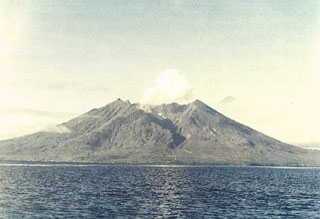Report on Kie Besi (Indonesia) — 2 March-8 March 2016
Smithsonian Institution / US Geological Survey
Weekly Volcanic Activity Report, 2 March-8 March 2016
Managing Editor: Sally Sennert.
Please cite this report as:
Global Volcanism Program, 2016. Report on Kie Besi (Indonesia) (Sennert, S, ed.). Weekly Volcanic Activity Report, 2 March-8 March 2016. Smithsonian Institution and US Geological Survey.
Kie Besi
Indonesia
0.32°N, 127.4°E; summit elev. 1357 m
All times are local (unless otherwise noted)
PVMBG reported that seismicity at Makian increased at the beginning of January and was characterized by deep volcanic earthquakes, low-frequency events, and tremor. Tremor amplitude increased at the beginning of March. Gas emissions did not change; weak solfatara emissions continued to rise from the crater floor. The Alert Level was raised to 3 (on a scale of 1-4) on 7 March. Residents and tourists were reminded not to approach the crater within a radius of 1.5 km.
Geological Summary. Kie Besi volcano, forming the 10-km-wide Makian island off the west coast of Halmahera, has been the source of infrequent, but strong eruptions that have devastated villages on the island. The large 1.5-km-wide summit crater, containing a small lake on the NE side, gives the peak a flat-topped profile. Two prominent valleys extend to the coast from the summit crater on the north and east sides. Four cones are found on the western flanks. Eruption have been recorded since about 1550; major eruptions in 1646, 1760-61, 1861-62, 1890, and 1988 caused extensive damage and many fatalities.
Source: Pusat Vulkanologi dan Mitigasi Bencana Geologi (PVMBG, also known as CVGHM)

